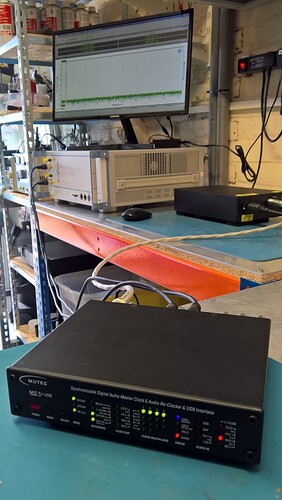Dear Community
I’m a recent member to this forum and have been charting (in various threads) my experience with my recent dCS purchases, and system re-configuration. I have been avidly consuming the many interesting topics/threads , especially on clocking. Not wanting to re-open old threads, and certainly not going over the same old ground again, I decided to start a new thread specifically on the Mutec MC3+USB product. I read about this here and an opportunity arose to purchase a used one, and as luck would have it, a second Kimber digital co-ax to match one I bought donkey’s years ago, to use as a clock cable (more later). I have also been in contact with a really helpful chap, Tony (Tech. Director) at Coherent Systems (https://coherent-systems.co.uk/) who have a great deal of experience, expertise and different ideas (to what I’ve read here) on digital playback.
Now to the point. I had my Network Bridge and Scarlatti DAC (SD) connected via AES, and the Scarlatti Clock-out feeding the NB. Then I purchased the MC3, based on valuable comments here, and other feedback, with the aim of using it as a master clock for the SD and NB. For me, the USB functionality is not required, but there are 3 features of the MC3 that appealed to me:
- It will provide a good WCLK output, which should give me a SQ improvement;
- Furthermore, a reference 10mHz clock can be fed to the MC3 in the future to improve the clocking;
- It will re-clock the data with its internal, or external clock, and output digitally.
From threads on this forum, it seemed that providing a master clock, or re-clocking the data, were two separate functions, individually giving their own results, and it was also thought that to provide multiple clocks, you’d need one MC3 for each clock frequency.
I firstly connected the MC3 to provide my NB and SD with a 44.1 khz clock, using my two Kimber D60 cables and some good quality 75 Ohm BNC adaptors from RS Spares. There was a great improvement along the lines of what everyone else says in relation to how the stack responds to external clocking. I was quite happy with this setup and wondered what adding a Mutec Ref10 might do … That’s when I got talking to Tony and his first reaction was “why are you only using the MC3 as a clock generator…?” Its main feature is to re-clock the data and this can be done as well as providing a clock. Sure it will require more cables, but the improvement would be worth it and I’d need to hear the MC3 at its best before adding any more clocks, etc. (Coherent Systems do their own Mutec product pimping!).
Now I have the MC3 providing a clock to the NB and SD, AND I have the AES output of the NB feeding the MC3, and its AES output feeding the SD. My SD still recognises it is receiving a WCLK at 44.1 khz. So my MC3 is now doing all it was designed to do in the scenario of providing a master clock and reclocked data (to that same clock). And yes there is a further improvement, all along the same lines as the reclocking improvements. (I’m afraid I don’t use terms like “next level”, etc. as there is no (standard) quantifiable measure for an audio experience, suffice to say I heard a difference which I liked and I wouldn’t revert to what I had before.).
Thus new connection setup means I could put my CD transport back into the system; though it doesn’t have a clock in/out (being an old Mark Levinson), it would get the data reclocked before it reached the SD, i.e. I’d simply move the AES plug out of the NB output and connect it to the CD; no settings need changing. I’ve not tried this yet but will certainly do so before investing in a matching digital AES cable (I have two mis-matching ones at the moment as my wife is very suspicious about all these cables I’m acquiring!).
And here’s the (hopefully) final bit of good news … a quote from Tony “Yes the Mutec will automatically detect and respond to incoming data rates upto 192Khz on AES and will adjust the WC output accordingly.
No need to touch the word clock settings at all”. Thus if your NB randomly receives 44.1 or 48khz based data, the MC3 will adjust accordingly and thus no need to have 2x MC3s, one for each clock. I haven’t got into this side of things yet (and working out the MC3 clock multipliers) as I’m just listening to my ripped CD library, but will certainly explore Qobuz, and the like very soon.
That’s it (for now); my system has the MC3 fully integrated. I have the future option of investigating MC3 upgrades via Coherent Systems, and/or adding a Ref10, all in good time. I’m still adjusting to all these changes and wanting to hear my music right through!
I’d be interested to hear how any of the MC3 owners on this forum have theirs connected; to what and how, and your feedback. Hopefully there’s a photo below of Tony’s MC3 showing how the LEDs are configured for the above mentioned setup 
